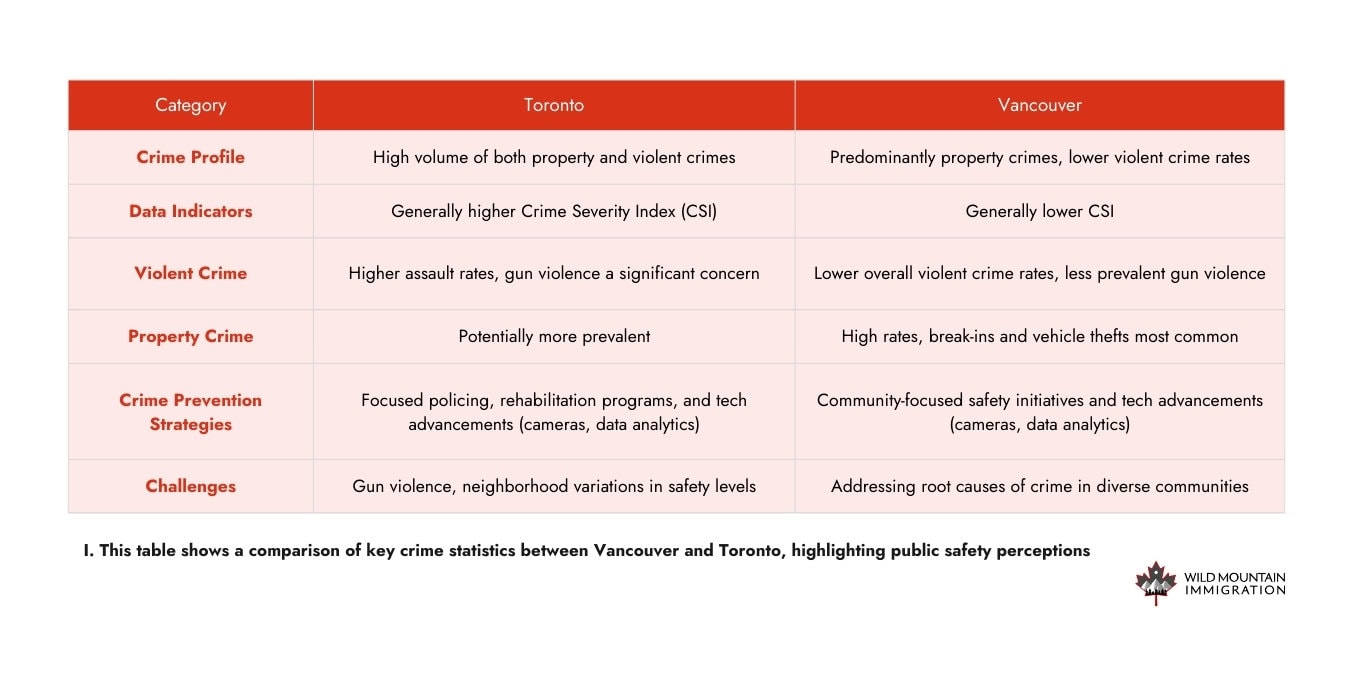When considering relocation, travel, or even simple curiosity about Canadian cities, one critical question often arises: “Is Vancouver safer than Toronto?” Safety is a multifaceted aspect of urban life, influencing everything from real estate choices to personal daily habits. In this blog post, we aim to provide an objective comparison of the two cities by examining various crime rates, delving into community safety measures, and analyzing factors that influence the perception and reality of safety, directly impacting the question, “Is Vancouver safer than Toronto?”.
Both Vancouver and Toronto are renowned for their vibrant urban culture, diverse populations, and significant roles in the Canadian economy. However, understanding the nuances of safety in these cities requires a deeper look into statistics and initiatives at the municipal level. By comparing crime rates, exploring safety initiatives, and discussing the effectiveness of various crime prevention strategies in both cities, we aim to paint a clearer picture of what it means to be safe in Vancouver and Toronto.
Stay tuned as we break down crime statistics and uncover the layers of safety measures implemented in both cities, providing insights that will help you decide which city might be safer and better suited for your lifestyle.
Immigration news directly into your inbox
Crime Rates in Vancouver vs. Toronto
When comparing the safety of two major cities like Vancouver and Toronto, one of the first aspects to examine is their crime rates. Understanding these figures helps provide a baseline for assessing overall safety.
Vancouver: A Snapshot of Crime Rates
Vancouver, known for its picturesque landscapes and high quality of life, reports a range of crime statistics that vary from minor thefts to more serious offenses. In recent years, property crimes, particularly break-ins and vehicle theft, have been more prevalent than violent crimes. However, there has been a noted increase in certain areas, pushing local law enforcement to adapt and intensify their crime prevention strategies.
Additionally, let’s explore some external sources for further insights:
Vancouver Police Department (VPD):
- The VPD provides detailed crime statistics based on their records management system. These statistics help identify trends, allocate resources, and evaluate enforcement and prevention initiatives.
- Keep in mind that official crime statistics may be two to three months behind due to quality control processes. Monthly summaries can change slightly as new data comes in.
AreaVibes:
- Vancouver’s crime rates are 25% higher than the national average.
- Violent crimes in Vancouver are 6% lower than the national average.
- Residents have a 1 in 19 chance of becoming a victim of crime.
- Year over year, crime in Vancouver has decreased by 5%.
CrimeGrade:
- Vancouver ranks in the 56th percentile for safety, meaning it’s safer than 44% of cities.
- The rate of crime in Vancouver is 36.21 per 1,000 residents during a standard year.
Toronto: Crime Statistics Overview
Toronto, Canada’s largest city, with over 2.7 million residents, presents a complex picture of urban crime. While overall crime rates have decreased in recent years, Toronto experiences higher rates of violent crimes compared to Vancouver. The city’s Crime Severity Index (CSI) has fluctuated, but generally sits above Vancouver’s, indicating a higher volume and/or severity of reported crimes.
Here’s a breakdown:
- Overall Crime Rates: While Toronto has seen a decrease in overall crime rates in recent years, it still experiences higher rates compared to Vancouver.
- Violent Crime: Toronto has historically had higher rates of violent crimes compared to Vancouver.
- Crime Severity Index (CSI): This index considers both the volume and severity of reported crimes. Toronto’s CSI has fluctuated, but generally sits above Vancouver’s, suggesting a higher volume and/or severity of reported crimes in Toronto.
- Neighborhood Variations: The city’s diverse neighborhoods experience different levels of safety. While some areas boast low crime rates, others face significant challenges related to gun violence and gang activities.
The city’s diverse neighborhoods experience different levels of safety. While some areas boast low crime rates, others face significant challenges related to gun violence and gang activities. The Toronto Police Service provides detailed neighborhood crime statistics to help residents stay informed.
Comparative Analysis
Comparing the two cities, Toronto generally has a higher crime rate per capita, reflecting its larger size and denser urban environment. However, it’s crucial to consider that the nature and frequency of crimes can vary widely within different neighborhoods of each city. Thus, while overall statistics provide a useful overview, they may not fully represent the day-to-day safety experienced by residents in various parts of each city.
Both Vancouver and Toronto have their unique challenges and strengths when it comes to managing urban crime. By examining these crime rates more closely, residents and potential movers can gain a better understanding of which areas might be safer or more risky, contributing to the ongoing debate on whether Vancouver is safer than Toronto.

Safety Measures: A Comparison
When evaluating whether Vancouver is safer than Toronto, it’s crucial to consider not only the crime rates but also the safety measures each city implements. Both Vancouver and Toronto have developed various strategies to enhance public safety, but their approaches and the effectiveness of these measures can differ significantly.
Safety Initiatives in Vancouver
Vancouver tackles crime through a multifaceted approach. The Vancouver Police Department (VPD) fosters community vigilance through neighborhood watch programs, which have been linked to reduced property crime. Public awareness campaigns educate residents on prevention strategies. Vancouver strategically utilizes surveillance cameras while balancing privacy concerns. Finally, improved street lighting in key areas enhances nighttime safety, with studies suggesting a connection to lower crime rates. This combination of community engagement, responsible technology use, and environmental design aims to create a safe and secure city for all.
Safety Measures in Toronto
Toronto’s approach to safety includes a mix of aggressive policing and community outreach programs. The Toronto Police Service has implemented several high-profile strategies aimed at reducing violent crime, such as the “Focused Enforcement” initiative which targets high-crime areas with increased police presence.
Additionally, Toronto has developed programs to address the root causes of crime, including youth outreach and anti-violence interventions.
Evaluating Effectiveness
Comparing the effectiveness of safety measures in Vancouver and Toronto requires looking at the impact of these strategies on crime rates and public perception of safety. Studies and surveys often provide insights into how residents feel about their safety, which is a key indicator of the success of local policies. For instance, areas with active community engagement and comprehensive safety strategies tend to report higher levels of perceived safety among inhabitants.
Both cities continue to evolve their safety measures, adapting to new challenges and technological advancements. By understanding these efforts, residents and visitors can better appreciate the complexities of urban safety and the ongoing efforts to maintain peace and security in these major Canadian cities.

Exploring Vancouver's Safety Initiatives
Vancouver’s approach to ensuring the safety of its residents and visitors is both comprehensive and community-focused. The city’s strategy revolves around preventive measures and active community participation to address crime proactively. Here’s a deeper look at some of the key safety initiatives currently in place in Vancouver.
Community Policing Centers
Vancouver has established numerous Community Policing Centers (CPCs) throughout the city. These centers are collaborations between the police and community volunteers to promote safety and security. They serve as hubs for information, education, and engagement on safety issues, facilitating a strong connection between law enforcement and the community.
Mental Health and Addiction Strategies
Recognizing the link between mental health and addiction and public safety, Vancouver has implemented targeted programs. A key initiative is the Car 87/88 program, which pairs police officers with registered nurses or psychiatric nurses. This approach has shown promise, with studies suggesting it can lead to better outcomes for people in crisis and reduce unnecessary arrests. Vancouver Police Department data shows Car 87 and 88 teams responded to around 2,500 calls in 2022, highlighting the program’s significant role in addressing mental health concerns within the community.
Use of Technology in Crime Prevention
Technology plays a pivotal role in Vancouver’s crime prevention strategy. The city utilizes CCTV cameras in high-crime areas and employs data analytics to predict and respond to crime patterns. This technology-based approach allows for more efficient use of resources and helps in quick response to incidents, thereby potentially reducing crime rates.
Public Engagement and Education
Vancouver places a strong emphasis on public engagement and education as vital components of its safety initiatives. Regular workshops, seminars, and community forums are held to educate residents on personal safety practices and to discuss community concerns. These forums serve as platforms for dialogue between the community and law enforcement, fostering a sense of shared responsibility for safety. Here, one might ponder, “Is Vancouver safer than Toronto?”—a question these initiatives aim to address positively.
Environmental Design
Crime Prevention Through Environmental Design (CPTED) is another cornerstone of Vancouver’s safety approach. This strategy includes urban planning that encourages active use of environments, such as well-lit public spaces, clear sightlines, and strategic placement of landscaping to deter criminal activities.
These initiatives illustrate Vancouver’s multifaceted approach to safety, focusing not only on immediate crime prevention but also on creating a sustainable environment where safety is maintained through community involvement and innovative strategies.

Canadian Immigration Consultant
Need help with your immigration journey in Vancouver?
Our professional team provides personalized support to guide you through the complex process. From work visas to permanent residency, let us help you achieve your goals.
Toronto's Crime Prevention Strategies
Toronto, as Canada’s most populous city, faces unique challenges in managing crime and ensuring public safety. The city has implemented a variety of strategies aimed at reducing crime rates and enhancing the sense of security among its residents. Here is an in-depth look at some of the key crime prevention measures in Toronto.
Focused Policing Initiatives
Focused policing, a key strategy for Toronto, allocates more police presence and resources to high-crime areas identified through data analysis. This aims to deter crime through increased visibility and faster response times. Studies show mixed results on long-term effectiveness, but some research suggests short-term crime reductions in targeted areas.
Toronto acknowledges this complexity and strives for a balance. They dedicate a significant portion of police resources to focused policing and recognize the importance of building trust with residents through community engagement initiatives. This approach highlights Toronto’s effort to tackle crime with both enforcement and community-based solutions.
Community Outreach Programs
Understanding that crime prevention extends beyond policing, Toronto has also invested heavily in community outreach programs. These initiatives aim to engage youth, support marginalized communities, and foster better relationships between residents and law enforcement. Programs like community policing forums and workshops help address the social and economic factors that contribute to crime.
Technological Enhancements in Public Safety
Toronto leverages technology for public safety. A network of surveillance cameras, estimated between 15,000 and 19,236, deters crime and assists investigations. Advanced data analysis predicts crime trends, allowing for targeted police patrols. Digital reporting tools empower residents to easily report suspicious activity, potentially preventing more serious incidents. These advancements highlight Toronto’s focus on proactive crime prevention through technology.
Legislative Measures and Gun Control
In response to concerns about violent crime, particularly gun violence, Toronto has advocated for stricter gun control measures and tougher legislation on firearm offenses. These efforts are part of a broader strategy to reduce the availability of illegal weapons and the incidents of gun-related crimes. The question “Is Vancouver safer than Toronto?” often arises in discussions about gun control, as the two cities adopt different approaches to this contentious issue.
Rehabilitation and Reintegration Programs
Toronto takes a comprehensive approach to crime prevention, recognizing that long-term safety hinges on reducing recidivism. They prioritize rehabilitation programs for offenders. Statistics Canada reports participation in these programs lowers recidivism rates by 25% within three years compared to no participation.
Furthermore, they understand the importance of employment in reducing recidivism. Studies show formerly incarcerated individuals employed within a year of release are less likely to re-offend. Toronto offers programs providing job training, resume writing assistance, and connections to potential employers, demonstrating their commitment to addressing both the symptoms and root causes of crime.

Breaking Down Crime Statistics in Both Cities
Delving into the specifics of crime statistics provides a foundation to more creatively address the question “Is Vancouver safer than Toronto?” This comparative analysis not only reveals the volume and types of crimes in each city but also gives a deeper insight into their safety dynamics.
Vancouver Crime Statistics
Vancouver predominantly experiences property crimes such as break-ins and vehicle thefts, which are the most reported offenses. While the incidence of violent crimes remains relatively low, especially when compared to larger global cities, there is an ongoing effort to further reduce these occurrences through community-focused safety initiatives. Understanding these statistics helps to unpack whether Vancouver’s reputation as a safe city holds true against its eastern counterpart.
Vancouver’s crime profile leans towards property crimes. Here’s a breakdown:
- Property vs. Violent Crime: Property crimes dominate, with break-ins and vehicle thefts being the most reported offenses.
- Decreasing Property Crime: While property crime rates have fluctuated, there’s a general downward trend.
- Lower Violent Crime: Vancouver boasts relatively low violent crime rates, especially compared to larger global cities, with its Crime Severity Index typically below the national average.
- Community Focus: Despite its reputation for safety, Vancouver remains proactive with community-focused safety initiatives to further reduce crime.
Toronto Crime Statistics
With its larger population, Toronto presents a more complex crime profile that includes a significant volume of both violent and property crimes. The city’s diverse demographics and dense urban structure contribute to its varied crime landscape. As Toronto grapples with challenges like gun violence and assaults, its crime prevention strategies are continuously tested. This context is essential for examining whether Toronto’s safety measures are robust enough compared to those in Vancouver.
Toronto’s larger population contributes to a complex crime profile:
- Crime Volume: Toronto experiences a significant volume of both violent and property crimes. Its Crime Severity Index (CSI) is generally higher than Vancouver’s, indicating a greater volume and/or severity of reported crimes.
- Property vs. Violent Crime: Property crimes may be more prevalent, but violent crimes like assault are a concern, with Toronto historically having around 20% higher rates of assault compared to Vancouver.
- Neighborhood Variations: Safety levels differ significantly across neighborhoods. While some areas boast low crime rates, others face challenges related to gun violence and gang activities.
- Challenges: Gun violence is a significant concern, with Toronto experiencing around 1,241 gun-related calls for service in 2022.
Comparative Analysis of Crime Types and Trends
A side-by-side comparison of crime types and trends in Vancouver and Toronto illustrates distinct differences: Vancouver’s crime scene is largely dominated by property offenses, whereas Toronto faces a broader spectrum of crime, including higher levels of violent incidents. This comparison is pivotal in addressing the overarching question, “Is Vancouver safer than Toronto?” by highlighting the specific areas each city struggles with or excels in.
Statistical Analysis and Predictive Trends
Both cities employ modern statistical tools and predictive analytics to not only understand past crime patterns but also to forecast potential future crime hotspots. This proactive approach is crucial in planning effective crime prevention strategies and in resource allocation, which directly impacts perceptions of safety and actual crime rates.
Public Perception and the Impact of Crime Statistics
The perception of safety in Vancouver and Toronto is greatly influenced by these crime statistics, but personal experiences and media portrayals also play significant roles. Both cities work hard to maintain transparency and engage their communities, ensuring that residents are not only informed but also actively involved in enhancing their safety.

Immigration news directly into your inbox
Factors Influencing Safety in Vancouver and Toronto
To fully understand the safety dynamics between these two major cities, it’s important to consider various factors that contribute to urban safety. This analysis will help us better answer the question, “Is Vancouver safer than Toronto?”
Demographic Factors
Demographics play a role in crime rates. Younger populations tend to experience higher crime volumes, and Toronto’s larger young adult population reflects this trend. Lower income and education levels can also be linked to increased crime. Recognizing these factors, both Toronto and Vancouver aim for targeted safety measures.
Analyzing demographics allows them to allocate resources to high-risk communities and design crime prevention strategies specific to each population group. This data-driven approach ensures interventions address the root causes of crime within different communities.
Urban Planning and Design
Effective urban planning and design play crucial roles in crime prevention. Cities that prioritize safety in their urban layout can significantly mitigate crime. Vancouver employs strategies like Crime Prevention Through Environmental Design (CPTED), which includes better street lighting and secure public spaces. Conversely, Toronto faces challenges from its rapid growth, which can sometimes result in planning oversights that inadvertently create environments conducive to crime.
Socio-Economic Factors
Economic conditions and social disparities are profound influencers of crime. Both cities have neighborhoods with higher unemployment and poverty rates, which correspond to higher crime rates. Addressing these socio-economic issues is critical for reducing crime in both locales. This leads us to consider, “Is Vancouver safer than Toronto?” when comparing how each city manages these economic disparities.
Government and Policing Policies
Government policies significantly impact safety. Toronto employs a multifaceted approach with focused policing, rehabilitation programs, and community engagement. Studies show mixed results for focused policing long-term, but rehabilitation programs can reduce recidivism.
Vancouver leans towards community-focused solutions like community policing, social programs to address crime’s root causes, and harm reduction initiatives. Analyzing the outcomes of these distinct approaches helps us understand what strategies best promote safety.
Community Cohesion and Social Capital
Strong community networks and social capital can significantly enhance safety. Community groups and organizations in both Vancouver and Toronto play essential roles in fostering a sense of solidarity and mutual responsibility among residents, which in turn helps reduce crime. This aspect of social infrastructure is crucial for sustaining urban safety.

Conclusion: Deciding Which City is Safer
When addressing the question “Is Vancouver safer than Toronto?” it becomes clear that each city has its own set of advantages and challenges related to safety. Vancouver, with its robust community policing and preventive safety measures, often enjoys a reputation for being calm and manageable. However, it does face its own challenges, especially with property crimes and isolated spikes in certain types of violent crime. On the other hand, Toronto, despite its higher crime rates, particularly in terms of violent crime due to its larger population and greater urban density, has implemented extensive crime prevention strategies and community outreach efforts that contribute significantly to public safety.
Ultimately, determining which city is safer is not just about comparing crime statistics; it involves analyzing the effectiveness of each city’s safety initiatives, the community’s perception of safety, and the quality of life. Both cities are continually evolving their safety strategies, striving to enhance the security and well-being of their residents and visitors. As such, the answer might vary depending on individual needs and perceptions, with some preferring Toronto’s vibrant urban life and others opting for Vancouver’s more relaxed environment.
Julce
Julce is an expert content writer specializing in topics about Canada, adept at blending practical advice with engaging stories that capture Canadian life.
Learn more about Vancouver
You will find helpful information about setting up in this vibrant and lively city.
Vancouver Social Groups: Connect, Network, and Build Friendships
Discover how Vancouver social groups can help you connect, network, and build lasting friendships in this vibrant city.
Moving to Calgary from Vancouver: What You Need to Know
Moving to Calgary from Vancouver brings new opportunities with its growing economy and affordable living. This guide provides essential tips to help you transition smoothly and enjoy your new city.
Edmonton vs Vancouver: West Coast or Prairie Cities?
Deciding between Edmonton vs Vancouver? Explore the unique lifestyles, attractions, and affordability of Canada's West Coast dream and Prairie metropolis!
Start Your Canadian Immigration Journey
Our experts make the process clear, stress-free, and successful, so you can move forward with confidence and focus on what matters most.

Contact Us
Immigration questions and service enquiries
Consultation
Speak to an expert
immigration consultant
"*" indicates required fields



